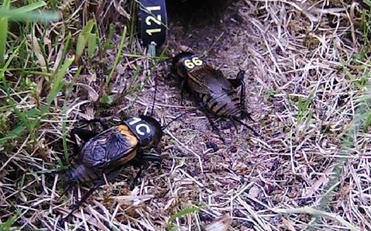Chivalrous crickets
Our study has turned the long-standing consensus on why insects hang out together after mating on its head. Instead of dominating their female partners through bullying and aggressive behaviour - the conclusion from lab observations, we find that males lay their lives on the line when their mates face danger.
|
|
It had been assumed that male insects stay close to females after mating to stop them from taking other partners. Female insects have multiple mates and the last mate is most likely to fertilise her eggs. Therefore, by preventing females from taking other mates a male is most likely to father her offspring. However, our males don’t seem to be aggressive towards their mates or hinder their movements to or from their burrow. Not only that, but males and females on their own have similar predation rates, but when they are in pairs, males are killed much more frequently and females always survive predator attacks. It’s not completely altruistic though - males are still benefiting. Even if a male is killed, the surviving female is carrying his sperm and ensuring that his DNA lives on.
|


